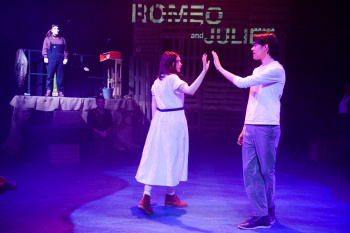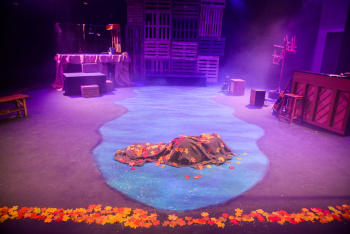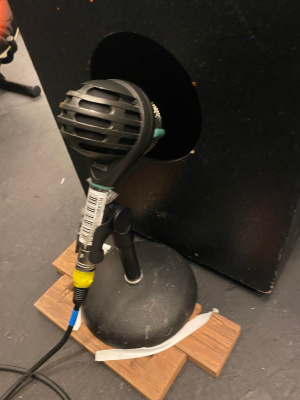The Dream: Difference between revisions
| Line 82: | Line 82: | ||
The design consisted of a 4m x 5m high pallet wall which could be projected onto throughout the show. To build this, we assembled the pallets based on their size and structural integrity and made them into 4 individual flats with A - Frame braces at the rear. | The design consisted of a 4m x 5m high pallet wall which could be projected onto throughout the show. To build this, we assembled the pallets based on their size and structural integrity and made them into 4 individual flats with A - Frame braces at the rear. | ||
[[File:RnJPallet_(2).jpg|Left|350px]][[File:Msproject.jpg|350px]] | [[File:RnJPallet_(2).jpg|Left|350px]][[File:Msproject.jpg|350px]][[File:51939589786_a9f5143c71_b.jpg|350px]] | ||
<pdf>The_Dream_Groundplan.pdf</pdf> | <pdf>The_Dream_Groundplan.pdf</pdf> | ||
Revision as of 14:35, 12 June 2022
Overview
The Dream was a mashup of A Midsummer Night's Dream and Romeo & Juliet.
Stage Department
The Dream, an unsupported small-scale show, became extremely technical stage heavy. From a 4m x 5m pallet wall to a flying pallet and microphone.
There were originally large issues with the scale of the show as the model box was made to the size of the room, not the size of the truss. This took a lot of sorting out.
Sustainability
Scotty reached a 100% sustainability goal on this show by sourcing each pallet from COP 26 which was running alongside The Dream. Each pallet was broken and the company Events Cycle helped us by sourcing all excess wood used on COP 26 and donating it to us for the show. The Tyres for the Stool trees were recycled from a local dealership.
Flying Pallet
RS2 is a venue made out of Self Climbing Truss And therefore didn't have access to counterweight flying like the Ath. To solve Juliet's flying balcony we used a tank trap screwed into the ground with a heavy bit of steel scaff pipe from the workshop and a cleat held on with half doughty couplers. Scotty picked the lightest pallet from COP 26 to use for the balcony, it used a Barrel Knot and 2 x Screw Eyes plus the leftover rope from Pyjama Game
Pallet Wall
The design consisted of a 4m x 5m high pallet wall which could be projected onto throughout the show. To build this, we assembled the pallets based on their size and structural integrity and made them into 4 individual flats with A - Frame braces at the rear.
Stage Management
Sound
PSE For this show, the setup was a fairly standard setup for a show in RS2 using the self climbing truss. We had an additional two spot speakers at the left and right of the stage, these originally were going to be wireless but this proved to be challenging and expensive so using wired speakers in the end worked very well.
We used;
4x KV2 EX6 2x Roland Cube Speakers (AV Store) 2x EV Subs (With the ev sub amp)
We had our RF Paddles attached to a scaff bar that was coming off the truss, this allowed us to have full levels of RF throughout the show with no issues. The wireless workbench file for this show was slightly difficult to set up. It is always worth checking what frequencies you have a licence to and making sure that all of your channels fit in these frequencies.
For this show, we had 12 Cast Mics using UR1 Transmitters, as well as 4 additional UR2 Transmitters that we used for our band, made up of a piano, two guitars and a ukulele. Guitar 2 and ukulele had pickups, which made these a very easy setup. The other guitar however, we taped an MKE MKII to just below the sound hole which gave us a pleasant all around sound with it being too harsh, or too boomy. For our piano, we were able to strap the UR2 transmitter to the leg of the piano, and run an MKE up just above the keys, and using tape we manages to push it away from the wood just enough in order to get a full-sounding tone, with some emphasis on the higher keys. Ideally, I would have liked to stereo mic the piano with some good small diaphragm condensers, but sadly this was not an option visually.
We also used a Sennheiser e906 to pick up a glockenspiel, we found that 6 inches above the keys was the ideal place for this mic. We used a D112 for the back of the cajon, again I would have liked to put an SM57 on the front of the cajon to pick up more of a snare sound, but we got a very punchy kick sound from the D112 with just enough high end to keep us happy. Lastly, we had a bass which ran through an amp, we then took the direct out of the amp and ran it into a DI Box before sending it to our stagebox.
Power plans were made in order to ensure no issues with power draw would occur thankfully even with in rush current (from the UHFR rack) then this never became an issue. For this show, I ran only one 16A cable up the truss, before splitting it on the truss into a 4-way 13A to power the speakers. This was great, as it meant that only one cable was coming down from the truss instead of 4. Sadly, we still had 4 XLRs coming down from the truss, in retrospect I would have liked this to be a 4-way XLR loom, and then we would only have two cables going up to the truss. I used this theory also when running lines on stage, I used an 8-way 20m Loom in order to act as a kind of stagebox.
Sound design
The dream was quite complicated for sound it featured a cast of 12 that all had hairline radio mic's for all the performances as well as filming and a band of seven instruments plus live foley. the most interesting part from a sound design perspective was the use of different effects on the casts voices. we wanted to create the idea of switching between the real world and an almost dream like state. In order to create these effects i used the built in effects on the SQ5 (reverb, Delay and a vocal plate) in various combinations and programmed them into scenes so that I could easily jump in and out of the effects.









